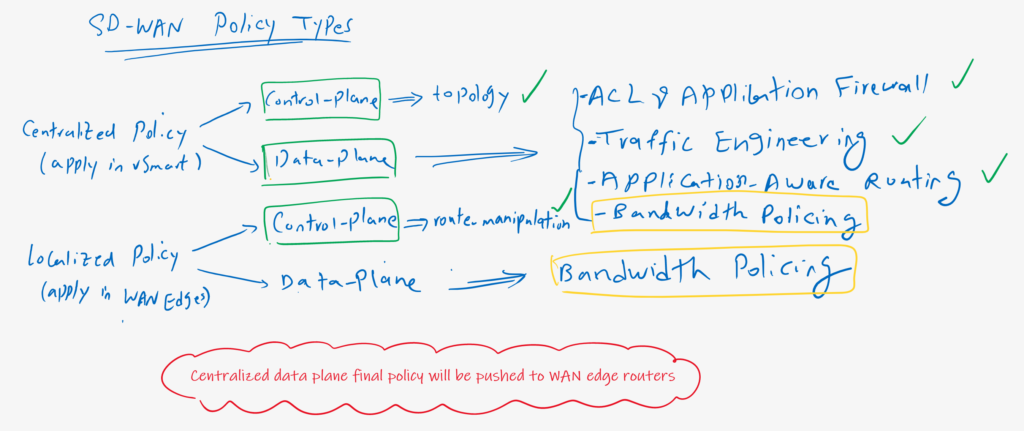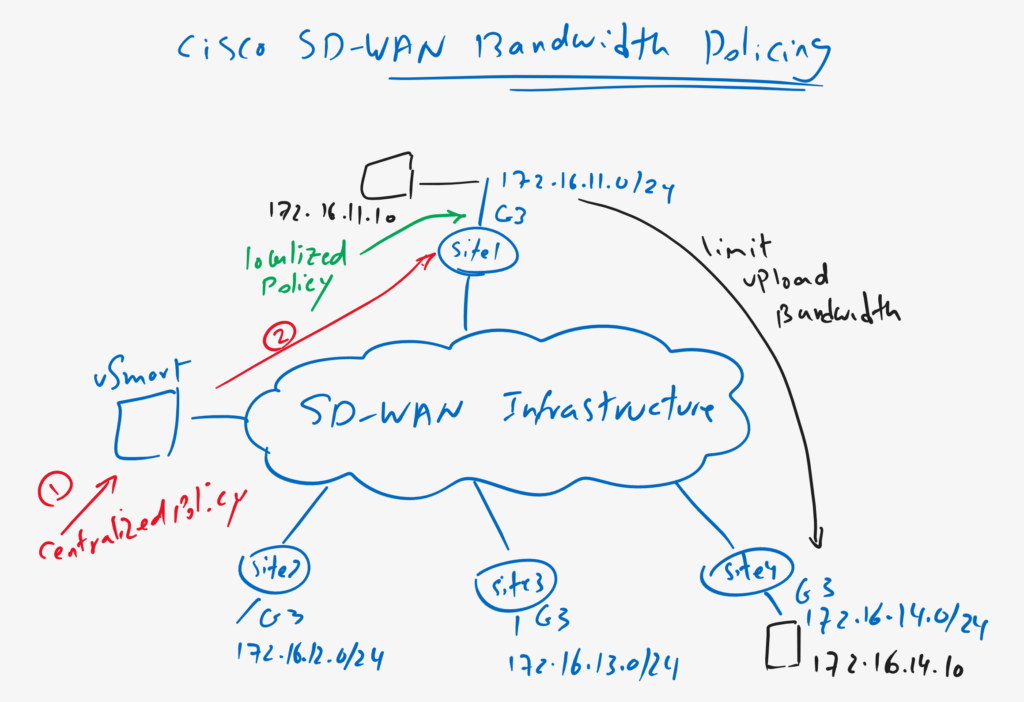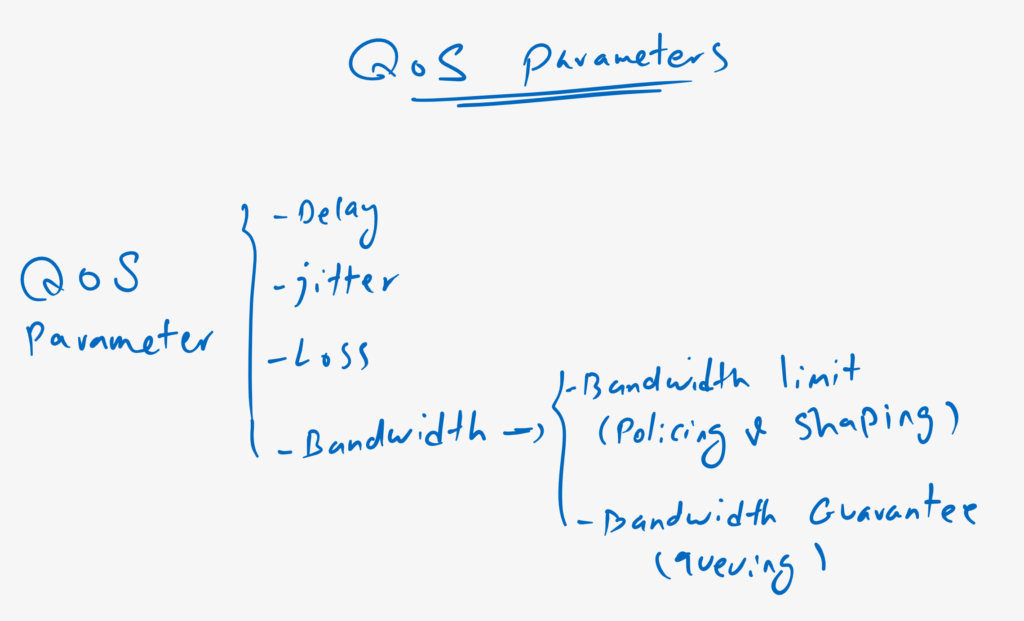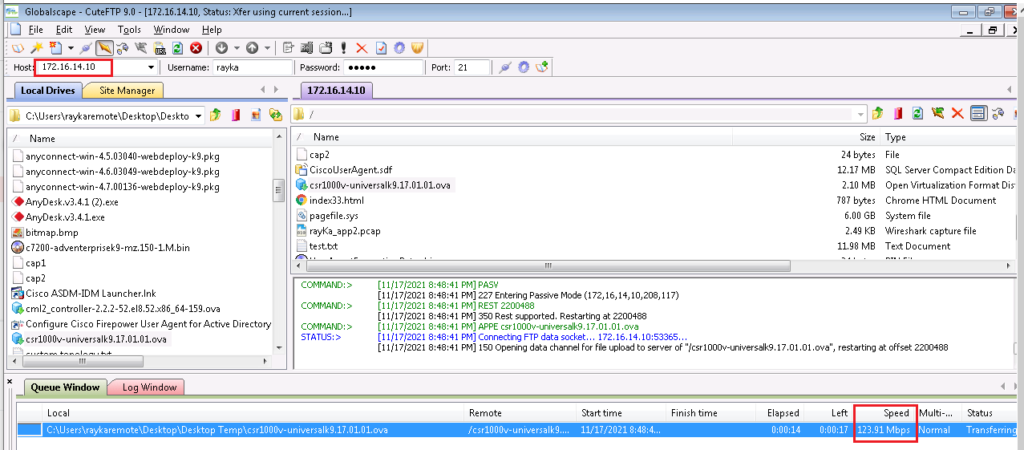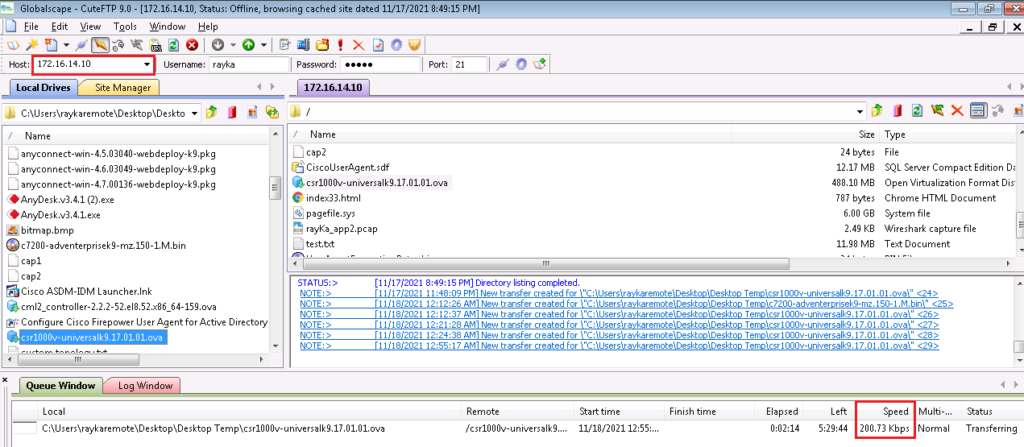Cisco SD-WAN Bandwidth Policing makes it possible to limit bandwidth of specific data traffic. It is a data plane policy which can be implemented both in localized and centralized policy.
Bandwidth Policing Overview
Although bandwidth policing is a data plane policy, but it can be implemented both through localized and also centralized policy.
We can push the policy directly to WAN edge routers through a localized policy, or it can be implemented via a centralized policy.
If a data plane policy such as bandwidth policing is implemented through a centralized policy, the final policy must be pushed from vSmart controller to WAN edge routers, otherwise it cannot affect data traffic since data traffic never goes through the vSmart controller.
Bandwidth Policing Topology Overview
This is the Topology in which we will implement bandwidth policing. Site1 to Site4 are connected to each other through existing SD-WAN infrastructure. all WAN edge routers are connected to the LAN side through Gigabitethernet3 and with IP Subnet 172.16.11.0/24 to 172.16.14.0/24.
As an example I have connected two computers behind Site1 and Site4 with IP Addresses 172.16.11.10 and 172.16.14.10. our target is to limit upload bandwidth from Site1 to Site4 to a specific value.
We will implement this scenario with both localized and centralized policy.
With localized policy, we apply the policy directly to gigabitethernet3 of the WAN edge router in Site1 in the direction from LAN to WAN. In the topology, it is shown with green color.
With centralized policy, policy will be applied to vSamrt controller but finally it will be pushed from vSamrt controller to Gigabitethernet3 of site1 WAN edge router so it can control data traffic bandwidth from site1 to site4.
QoS Parameters Oveview
Another important point to note is that delay, jitter, and loss are not the only QoS parameters which can control the quality of applications. But bandwidth is probably the most important parameter. Because if the bandwidth is sufficient for an application, we will have no delays, jitter or losses in our data traffic.
In QoS we have two options for bandwidth control. Bandwidth limiting that can be implemented using bandwidth policing or bandwidth shaping tools. Another option is to guarantee bandwidth of a given application, which can be implemented using queuing tools.
Cisco SD-WAN Bandwidth policing using Localized Policy
Before we start configuring bandwidth policing, let’s check how much bandwidth we have from Site1 to Site4 if there is no restriction. We check it with sending ftp traffic from site1 to site4.
As you can see, there is a high bandwidth connection between these two sites.
Configuring Policing using Localized Policy
As the first method, we implement bandwidth policing with localized policy.
In the first step we configure final allowed and restricted bandwidth, which we will limit from Site1 to Site4. Let’s configure it to 200kbps.
CONFIGURATION -> POLICIES -> Localized Policy -> Custom Options -> List -> Policer -> New Policer List
Policer List Name: 200kbps
Burst (bps): 200000
Exceed: Drop
Rate (bps): 200000Policy itself will be implemented through access control list policy in localized policy.
CONFIGURATION -> POLICIES -> Localized Policy -> Custom Options -> Access Control List -> Add Access Control List Policy -> Add IPV4 ACL Policy
Name: SITE1_to_SITE4_ACL
Description: SITE1_to_SITE4_ACL
Sequence 1:
Match:
Source IP Prefix: 172.16.11.0/24
Destination IP Prefix: 172.16.14.0/24
Action:
Policer: 200kbps
Counter Name: site1_to_site4_count
Default Action: AcceptNow we need to apply our access control policy to cEdge1 router.
There is already a localized data plane policy that is applied to the cEdge1 router named cEdge1_Policy. We will edit this policy to add our new access control policy.
CONFIGURATION -> POLICIES -> Localized Policy -> cEdge1_Policy -> Edit -> Access Control List -> Add Access Control List Policy -> Import Existing -> SITE1_to_SITE4_ACLNow we can preview our final commands that will be copied to cEdge1 router.
policy
access-list SITE1_to_SITE4_ACL
sequence 1
match
source-ip 172.16.11.0/24
destination-ip 172.16.14.0/24
!
action accept
policer 200kbps
count site1_to_site4_count
!
!
default-action accept
!
policer 200kbps
burst 200000
exceed drop
rate 200000
! But still it is not finished. Now we have to apply our access control list policy to Gigabitethernet3 interface in cEdge1 router and with the direction from LAN to WAN.
And the configuration changes when applying the access control list on gigabitethernet3 are as shown here.
# apply ACL to cEdge1 VPN 10 Interface
CONFIGURATION -> TEMPLATES -> Feature -> CSR1000v_Interface_Data_Center
Section: ACL/QoS
Ingress ACL - IPv4: On
IPv4 Ingress Access List: SITE1_to_SITE4_ACL
# cEdge1
sdwaninterface
interface GigabitEthernet3
access-list SITE1_to_SITE4_ACL inAgain we check our bandwidth from site1 to site4 with sending ftp traffic. we expect that bandwidth will be limited to 200kbps as we have configured.
At the same time we can check our bandwidth policy and if it effects traffic through CLI commands.
With command “show sdwan policy access-list-associations”, we can check which policy is applied to which interfaces.
cEdge1#show sdwan policy access-list-associations
INTERFACE
NAME INTERFACE NAME DIRECTION
-------------------------------------------------
SITE1_to_SITE4_ACL GigabitEthernet3 inWith command “show sdwan policy access-list-counters”, we check if traffics are matched with our policy.
cEdge1#show sdwan policy access-list-counters
NAME COUNTER NAME PACKETS BYTES
---------------------------------------------------------------
SITE1_to_SITE4_ACL default_action_count 1270906 1639796081
site1_to_site4_count 1129 1458863With command “show sdwan policy access-list-policers”, we can check the policy itself and how much traffic is matched with the policy.
cEdge1#show sdwan policy access-list-policers
POLICER OOS OOS
NAME NAME PACKETS BYTES
------------------------------------------------
SITE1_to_SITE4_ACL 1.200kbps 556 728474Cisco SD-WAN Bandwidth policing using Centralized Policy
As he second method, we will implement the same scenario but this time through centralized policy.
First we have to remove our current localized policy so we can make sure that traffic is matched with our new centralized policy.
# remove policy from interface
CONFIGURATION -> TEMPLATES -> Feature -> CSR1000v_Interface_Data_Center
Section: ACL/QoS
Ingress ACL - IPv4: default
# cEdge1
sdwaninterface
interface GigabitEthernet3
no access-list SITE1_to_SITE4_ACL inNow we can create our new centralized policy to limit bandwidth from site1 to site4.
If you remember, we have many options in the Centralized Policy and in the section “Traffic Policy”, some of which we implemented in the previous sections such as Access List, Traffic Engineering, and Application aware Routing. In this section we choose QoS as our policy type to configure bandwidth policing.
CONFIGURATION -> POLICIES -> Centralized Policy -> Custom Option -> Traffic Policy -> Traffic Data -> Add Policy -> Create New
Name: SITE1_to_SITE4_Policing
Description: SITE1_to_SITE4_Policing
Sequence Type: QoS
Sequence 1:
Match:
Source IP Prefix: 172.16.11.0/24
Destination IP Prefix: 172.16.14.0/24
Action:
policer: 200kbps
Counter Name: site1_to_site4_count
Default Action: AcceptNow our new bandwidth policing policy, must be applied to vSamrt controller. Already there is policy with the name of vSmart_Policy applied to vSmart controller. Our new policy will be added to existing vSmart_Policy.
First we have to add it into vSmart controller.
CONFIGURATION -> POLICIES -> Centralized Policy -> vSmart_Policy -> Traffic Rules -> Traffic Data -> Add Policy -> Import Existing -> SITE1_to_SITE4_PolicingThen we need to tell vSamrt controller which sites the policy needs to be copied to and in which direction.
Policy Application -> Traffic Data -> Section: SITE1_to_SITE4_Policing -> New Site List and VPN List -> From Service
Select Site List: HUB
Select VPN List: VPN10Before activating new policy, we preview the commands
viptela-policy:policy
data-policy _VPN10_SITE1_to_SITE4_Policing
vpn-list VPN10
sequence 1
match
source-ip 172.16.11.0/24
destination-ip 172.16.14.0/24
!
action accept
set
policer 200kbps
!
count site1_to_site4_count_-1451988374
!
!
default-action accept
!
policer 200kbps
burst 200000
exceed drop
rate 200000
!
lists
site-list HUB
site-id 101
!
vpn-list VPN10
vpn 10
!
apply-policy
site-list HUB
data-policy _VPN10_SITE1_to_SITE4_Policing from-serviceNow we can save and activate policy.
Let’s check again effective bandwidth from site1 to site4 with sending ftp traffic from site1 to site4.
At the same time, we check it with CLI command to make sure that the policy is pushed to cEdge1 router and traffics are matched with our policy
With command “show sdwan policy from-vsmart data-policy”, we check if policy is pushed from vSamrt controller to cEdge1 router.
cEdge1#show sdwan policy from-vsmart data-policy
from-vsmart data-policy _VPN10_SITE1_to_SITE4_Policing
direction from-service
vpn-list VPN10
sequence 1
match
source-ip 172.16.11.0/24
destination-ip 172.16.14.0/24
action accept
count site1_to_site4_count_469802181
set
policer 200kbps
default-action acceptWith command “show sdwan policy data-policy-filter”, we make sure if traffics are matched with our policy.
cEdge1#show sdwan policy data-policy-filter
data-policy-filter _VPN10_SITE1_to_SITE4_Policing
data-policy-vpnlist VPN10
data-policy-counter default_action_count
packets 2
bytes 317
data-policy-counter site1_to_site4_count_469802181
packets 2317
bytes 3016309
data-policy-policer 1.200kbps
oos-packets 764
oos-bytes 1002122
cEdge1#
